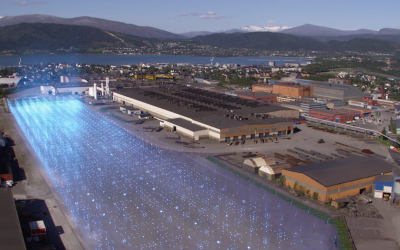The cement industry accounts for 6-8% of the world's total man-made CO2 emissions. At the same time, concrete is one of the most used building materials in the world today, and consumption is expected to increase with population growth and urbanization. It is therefore very important that large cement producers such as Norcem take action on their CO2 emissions.
Norcem is Norway's only cement producer and has factories in Brevik and Kjøpsvik. Norcem is wholly owned by Heidelberg Materials and operate the only two cement factories in Norway. Heidelberg Materials is one of the world’s largest integrated manufacturers of building materials.
The Norwegian government presented on September 21st 2020 that it would propose that money be allocated to establish a full-scale chain for capture, transport, and storage (CCS) in the proposal for the state budget for 2021, where Norcem Brevik would be responsible for the carbon capture. When the national budget was approved by the Storting, which allocated funds to realize the project. The factory in Brevik will build a full-scale facility for capturing CO2 from cement production. Liquid CO2 will be transported by ship to Western Norway for permanent storage under the seabed.
Will remove 1% of Norway's emissions
The Paris Agreement applies to all countries in the world, and the richest countries are expected to do the most. Countries such as Norway must take an active role and are dependent on innovation that contributes to achieving the goals. Norcem Brevik will be the world's first cement factory with full-scale carbon capture and shows that Norcem and Norway take the climate goals seriously.
Norcem's investment in carbon capture is part of Norcem's vision of zero emissions of CO2 from concrete products by the year 2030, and a move that gives the country's greenhouse gas efforts a seven-mile boost. This one plant will save Norway 400,000 tons of CO2 annually, which is almost 1% of the country's total emissions. Norcem Brevik will capture approx. 50% of its emissions. This is in addition to other improvements they have made in recent years to reduce their footprint.
How does it actually work?
What is carbon capture and storage, and how is it actually done?
CO2 is captured from the flue gas from cement production using proprietary technology. The flue gas from the cement production in Brevik is treated by adding chemicals that separate the CO2 and release the residual smoke. The CO2 is then stored temporarily, before it is sent by ship to Western Norway. Here it is transferred to an intermediate storage and then into pipes that send the CO2 down into a well below the seabed.
Put simply, what is happening in the capture project in Eastern Norway and the transport and storage project in Western Norway are both part of the Norwegian CCS demonstration project - or Langskip, as the government now calls it. The transport and storage project is owned by Northern Lights, which is a collaboration between Equinor, Shell and Total. The two projects are mutually dependent. The capture project must have a place to store what they catch, and the transport and storage project must have something to store. Together, the two projects will ensure that Norway realizes a complete chain for CO2 capture and storage. It's all a circular process.
Shall have the project management
A project management team from Metier will assist the project, and work closely with the business management in Norcem.
- This project is the largest environmental project in Norwegian industry ever. It is a very exciting and important project both for Norway and the rest of the world, says Jan Eklund, head of Construction at Metier. Through the development of new technology and the demonstration of full-scale CO2 capture and storage (Carbon Capture and Storage, CCS), the project will contribute to the necessary development of CCS, so that the long-term climate goals in Norway and the EU can be reached at the lowest possible cost.
- Metier's vision is to contribute to social development through better projects. A project of this type where we can not only contribute to the efficient utilization of our common tax funds, but also take part in the necessary journey towards a greener society, means that we are particularly looking forward to working together with Norcem to realize this project, says Jan further.
- The project is very important to us; the group and the industry, and incredibly exciting, says Per Brevik, director of sustainability at Heidelberg Materials Northern Europe. But our organization is primarily oriented towards operations, so that we are completely dependent on project manager expertise and assistance. Metier has been involved in the project from the time we were waiting for the decision from the Norwegian government. They have documented high competence and extensive experience from large projects, and we really look forward to continuing our good cooperation in the implementation phase.


